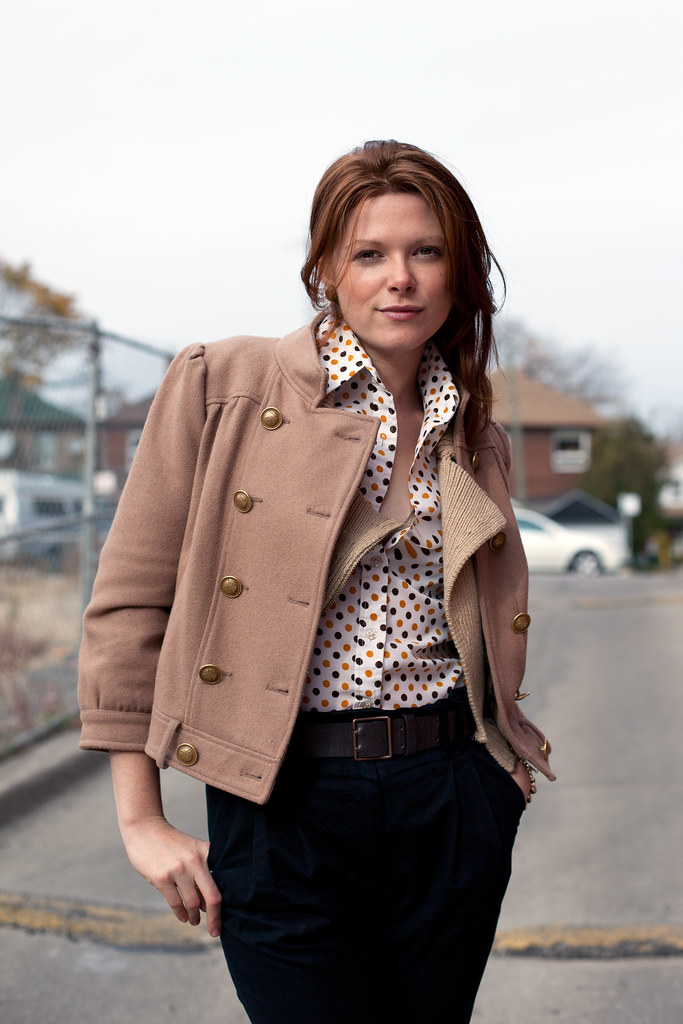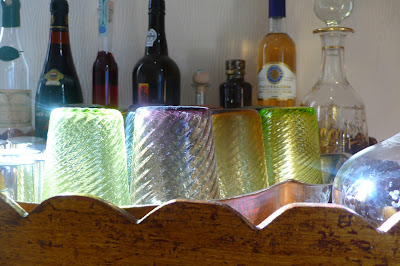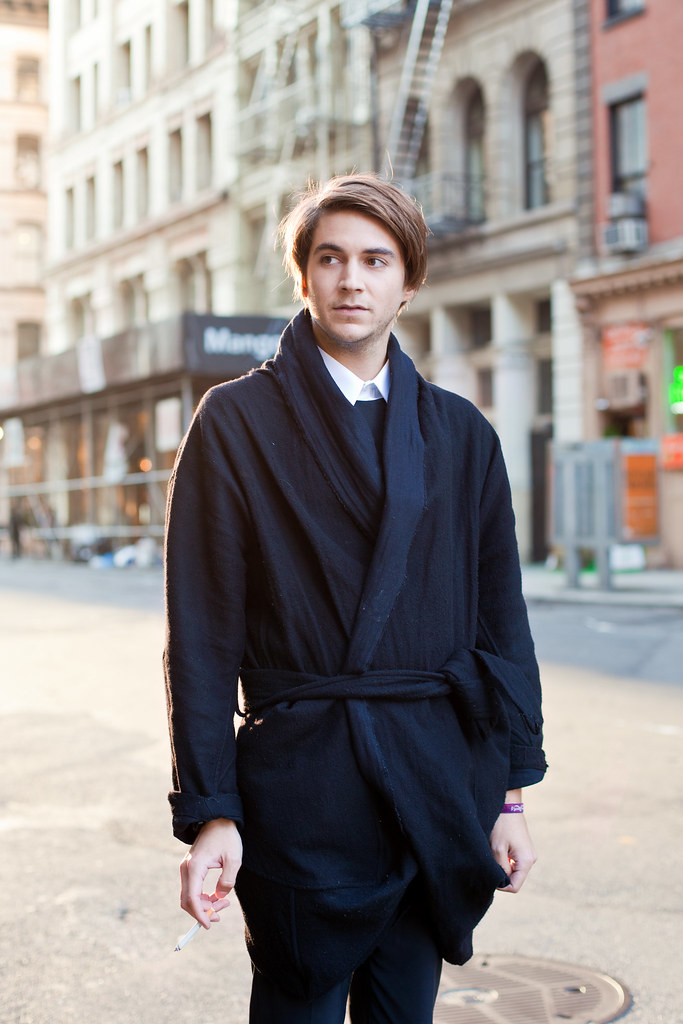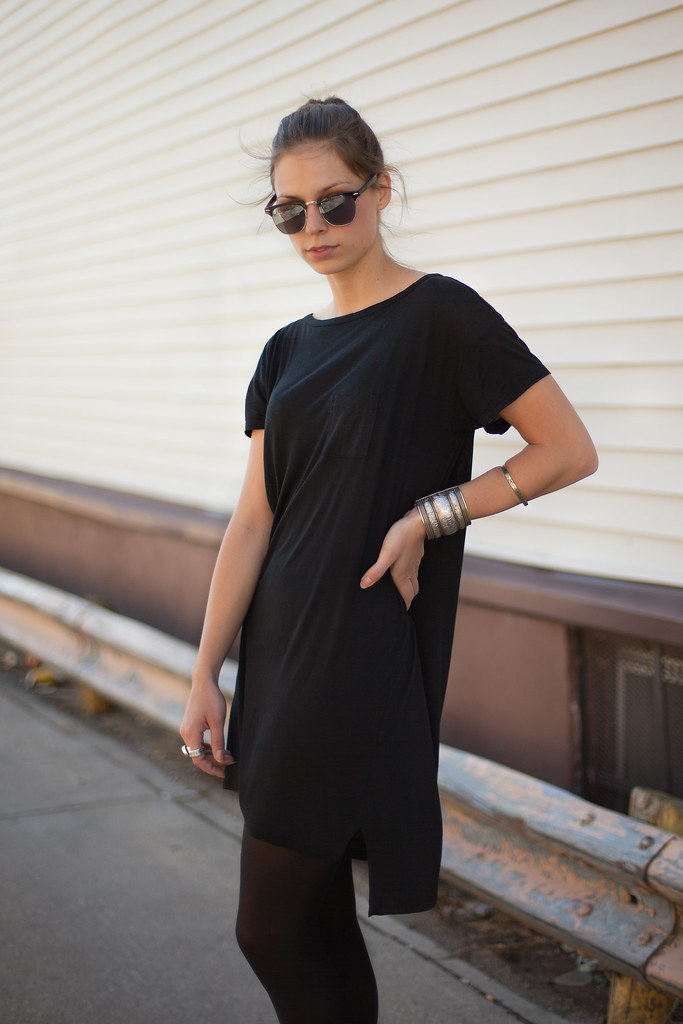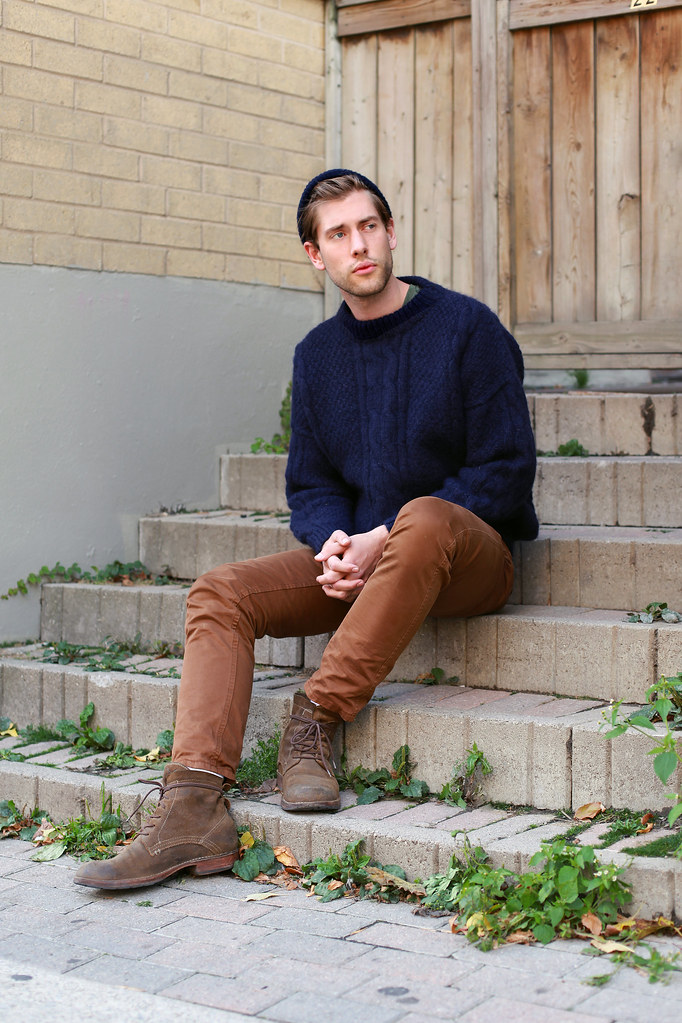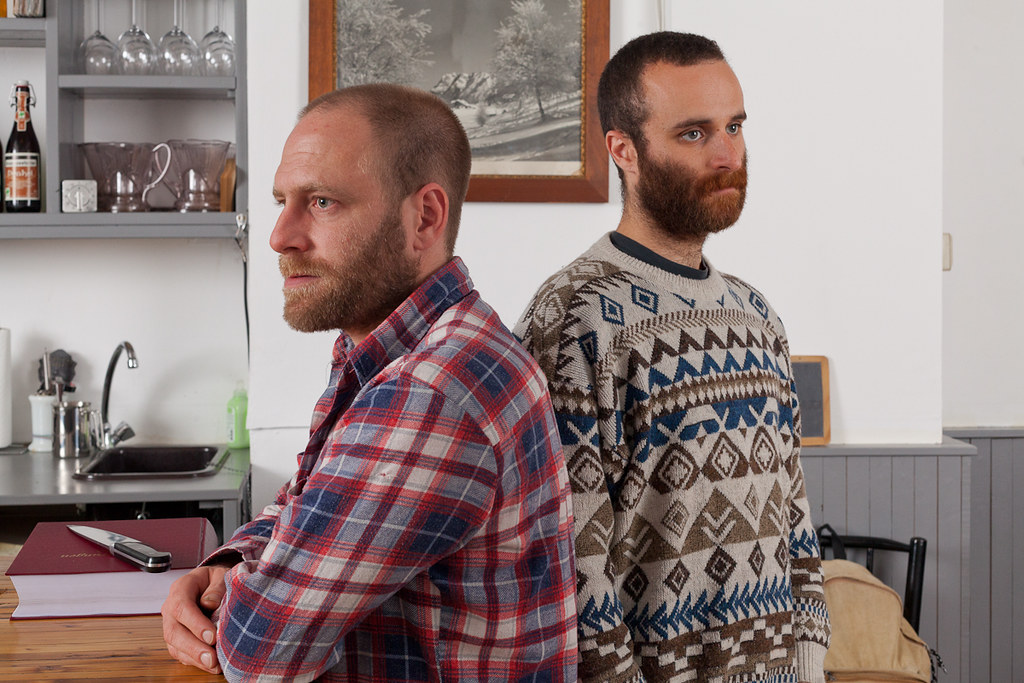
Kevin Avery and Jeffrey Sfire in their restaurant "Little Otik". Photo:
Trevor Good Jeffrey Sfire and Kevin Avery, two charming New Yorkers, came to Berlin two years ago and founded what was then new in town: the "Palisaden Supper Club". Once a month, the club opened for 10 people, where Jeffrey and Kevin invited them to their home to spoil them with a dainty three course meal made from regional and seasonal products they found at the markets. It was so successful that the couple decided to go for the real deal and when they found an abandoned space on Gräfestraße they knew it was the right time to turn their business into full time: "Little Otik" was born and it is named after the czech surrealist movie by Švankmajerová. To keep their life-work-balance the restaurant is only open at night from Wednesday to Saturday, and though it was just opened in August it is already wise to make a reservation (tel. 030-50362301). We sat down and talked to them about the taste of Berliners, why it is difficult to sell the oh-so-delicious pig's head meat and in the end they even gave an insight on this week's menu starring the last performance of what is going to be missed very soon: fruity tomatoes.
How did you come to Berlin?
Jeffrey Sfire : I came to Berlin to work as a DJ, that was what brought me and all of my friends here.
When was that?
Jeffrey: I started coming here five or six years ago just for summer, and to DJ, and I started meeting lots of friends and finally decided to move here. And at the same time Kevin was working at a small restaurant in New York that closed, so he came with me just to check it out for a few months. And then we ended up staying and starting the Palisaden Supper Club. And it really started from there, we didn't really know what was happening.
How did you get to the idea for the Supper Club?
Kevin Avery: We never thought about it before coming to Berlin. It wasn't like we wanted to move to do this thing. It just kind of happened after we came here. I came basically for a two month holiday and found a job the second day after I came here. If I hadn't found that job I probably wouldn't have stayed. It all seemed very meant to be. We thought of doing the Supper Club -- we'd try it once and see what happened and it just worked. We kept doing it and it became more and more interesting. Nothing was intentional. Doing the first Supper Club we didn't know what to expect and we didn't necessarily think we would do it once a month.
Inviting ten strangers to your home is still not very common.
Kevin: The concept is almost as old as mankind, people have done this for thousands of years, I think at some point it became less common and now it is becoming popular again. A thousand years ago, if you were on some dirty road in the middle of nowhere, there's a house and you would just go in there.
Did you get the idea in New York?
Kevin: Yes.
But you did not do it in New York?
Kevin: No, I was always working a lot of hours in restaurants, I had no time to do it. That was the thing about coming to Berlin, I found a job in a bakery for just about 25 hours a week, so I actually had time to do it. In New York you can't get by by working just 20 hours a week. Unless you are a bartender or something. But that was what gave us the opportunity to do it here, we didn't have to make as much money to survive.
So you did not intend to transform it into a restaurant?
Kevin: In New York I did not even think about anything like that - it would have been so expensive, and there is so much competition. And I've had so many friends opening a restaurant and they turned out all very similar, since they all are based on the same concept. Coming to Berlin seemed like the perfect opportunity to offer something that was not common here.
How was it to welcome 10 strangers in your own house?
Kevin: We never had any problems at all. There was only one person that made a reservation and didn't show up.
Only one?
Kevin: Yes. And everybody always came, everybody pretty much came on time, everybody was very kind and respectful. There were never any problems. Sometimes by the end of the night we were very tired and wanted everyone to leave, but people wanted to hang out. A lot of people asked for strange stories, but it was always very straightforward and pleasant. We never had any major disasters with the food.
Jeffrey: But we operated it like a restaurant - people came in, sat down, I served the food, people would chat and then it was over. We never tried to do anything more than that.
How long did you do it?
Kevin: The first one was in February 2009 and the last one was in May 2010.
Did you stop it because you found this place?
Kevin: Yes, we signed the contract in March and after May we were too busy with doing the renovation here. We opened in August.
How did you came to the decision to open a restaurant?
Kevin: It felt very natural.
Jeffrey: I started to look for a second location to do the supper club at, because it started to be annoying to do it at our house. We kept saying, if we had a location just for the Supper Club, we could do it more often and leave everything there. Then I started to look at renting a real restaurant. The big problem was also the kitchen, we've worked in a home kitchen where it was more difficult to make food on a very small stove.
Did you use the common Berlin type oven that everyone has?
Jeffrey: Yes
I only have three plates on mine, you had four?
Jeffrey: No, we only had three. And we bought an extra refrigerator, but it did not really work out.
Kevin: To make everything took so much longer.
So Kevin, you're a professional chef, right?
Kevin: I studied art in college, but I always worked in restaurants. There was this point where my passion for food became bigger than my passion for art, and I realized I was better at making food than I was at making art. In the beginning I was fighting against the food thing, because I really wanted to make art. But then I was fine with the realization that I was better at making food.
Was this in New York?
Kevin: Yes
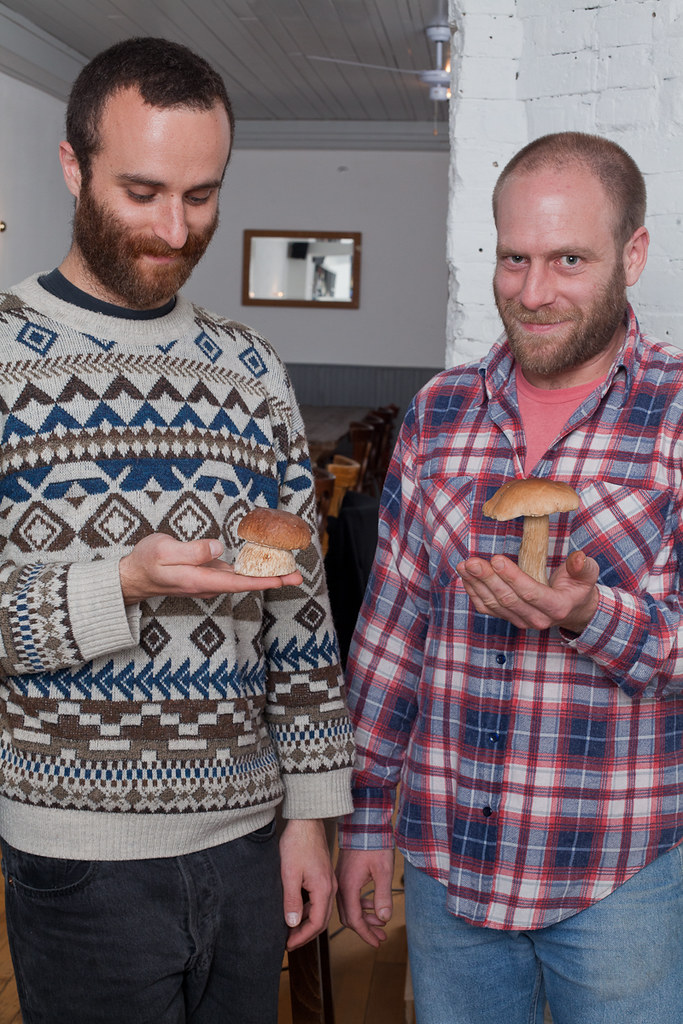
Do you both come from New York?
Kevin: No, my mother's family is from New York. I grew up in Connecticut and moved to New York when I was about 23 and lived there for 10 years.
Jeffrey: I grew up in Detroit and moved to Chicago, then New York. I lived in New York for four or five years before moving to Berlin. We met in New York.
Did you find this place by chance?
Jeffrey: Yes, we were just looking at listings.
Were you looking in this area?
Jeffrey: First we wanted to be on the other side of Kottbusser Damm. We thought it was a newer and up-and-coming neighbourhood. We spent months walking the streets and writing down numbers of empty spaces. In this time we learnt a lot about opening a business, changing a shop into a restaurant and how difficult this would be. We had seen this place here a few times and the condition was so bad that we just kept walking away from it because it was so trashed. The last restaurant owners moved out and it was empty for 6 or 7 months. And it was in a really bad condition and needed a lot of work. After a while we realized this is what we actually could do. It was the right price and a good location and so we decided to take it and totally renovated it.
What does that mean?
Jeffrey: Everything you see is new.
Kevin: 90 percent of it.
Jeffrey: The kitchen and the bathrooms were here and okay. That was the most important thing, that it was already a restaurant and had the main things in it - the Abzugshaube, the bathroom, the gas for the stoves, things like this. All we had to do was to make it look pretty.
Kevin: It had laminate floors and the ceiling was all styrofoam Stuck.
Jeffrey: They had these things coming from the ceiling that looked like in a Chinese restaurant, these crazy sculptures made out of styrofoam.
Kevin: And there was a tiki bar with a bamboo decoration.
Jeffrey: The whole place had been made by the last owners, self made. It was really bad.
Kevin: They built a counter against the windows, you couldn't open them. They painted the windows from the outside. It was very dirty, we kept finding food everywhere in the corners that has been there for months. It was trashed.
So you spent from March to July renovating?
Kevin: We did all the demolishing. We knew a carpenter and he did all the carpentry work, and the Hausmeister helped us a lot, he installed the floors. It was pretty easy but it took a lot of time.
Jeffrey: I had a lot of experience in construction renovation, because that's what my father does. To me it was really exciting. The floor is second hand from a gymnasium, a Turnhalle. We bought a lot of things at "Historische Bauelemente".
And what's with the tables?
Jeffrey: Those are market tables, we just built the bottom construction.
What kind of image did you have in mind?
Kevin: The easiest explanation is that I wanted it to look like the country house I never was able to have.
A cottage?
Kevin: Yes, exactly, It's like a model for what the eventual country house will look like. We wanted it to be very homey and grandma.
And what's with the name?
Kevin: "Little Otik" is one of my favorite films and I am very enamored by the director's creativity. The film has a food undertone, it is subtle..
What's it about?
Kevin: It's based on a Czech fairytale, about a couple that can't have a child. The husband cuts a wooden log in the backyard, that looks like a baby and the wife brings it to life in her need to have a child. But it turns out to be a monster and basically eats the entire village.
Okay.
Jeffrey: It has a huge appetite, and the people are constantly feeding it and they cannot bring it enough food and eventually it eats all the people
Kevin: You should watch it, it's a brilliant film and the director is amazing, it also has some stop animation in it. It is somewhat dark but very funny. A lot of people are put off be the explanation of the film, but I am enamored by the creativity of this person. It does not necessarily inspire me on food, but to do things I want to do. His visuals, dialogues and cinematography is all very powerful and special.
So let's talk about the food! Do you have a fixed menu?
Kevin: No, it depends. We print the menu everyday, at least one thing is changed everyday. Some things we really like we have for a month, some things we just have for a week. It changes all the time, but it is not completely different every week. Since the first week the menu has become much more rounded and better.
How do you choose the dishes?
Kevin: I am mostly inspired by vegetables. What is at the market, or what I want to eat. If I am really craving something then I will make a dish, so I can eat it. A lot of things I have been making forever, classic dishes, or interpretations of classic dishes.
How would you describe the style of your food.
Kevin: Sometimes I just want to say its like Oma Essen, rustic classic European food. There are some American things about it, but I really don't like to say American because it has a negative sound to it.
Sounds like fries and burgers…
Kevin: Exactly, with food, if you say something is American, people don't respect it.
Is there something to be respected about American food?
Kevin: Yes, of course!
Pumpkin?
Kevin: I think Europeans have a misunderstanding of American food. It is such a broad term, it can mean so many different things.
What does it mean to you?
Kevin: For me it's a concept of the melting pot of America, you can really take from any culture and create a dish, it doesn't have to be put in a box, like this is French, this is Italian. If it's American, one dish can be French, Italian and Turkish. There are probably more good restaurants in New York City than there are in the country of Germany, so that means something about American food.
So it's American food as long as it is made in America? I don't want to say anything against American food, but to me it's just fries.
Kevin: If you think of New York and its restaurant and food culture it is so much stronger than a lot of the European places..
As Berlin as well?
Kevin: Yes, I think so. It is very different. Americans are much more open to eating experiences. It Berlin it can be a struggle.
Jeffrey: I think Berlin is very different from other German cities.
What do you mean with struggle? Don't Germans have good taste in food?
Kevin: No, I don't mean that! But, coming from a different country it is very hard to understand what people want and expect.
But you have been pretty successful in making dishes Berlin based people like.
Kevin: Yes, but, for example, we try to use all organic ingredients. In New York this would be assumed by certain types of restaurants. Here people want to be told, they don't assume a certain level of quality based on the menu. You have to tell them: this is organic.
In New York it is different?
Kevin: Yes, it would just be assumed. Here you have to write it all over the menu if something is organic to have people pay a certain amount of money..
for the happy lamb?
Kevin: Exactly.
It shows their interest in what they are eating.
Kevin: Definitely.
Jeffrey: It's harder to make something that costs more in Berlin. So many people are just looking at the price before looking at the food and making assumptions just based on that. If people knew that small farmers, mostly only husband and wife are bringing us most of our vegetables and put so much care and love in all of it, this may justify it.
But your location is pretty good for not having a big struggle with that compared with places like.. Lichtenberg. Kreuzberg and especially this Kiez is pretty open-minded and relatively wealthy.
Kevin: Yes, but for example - I make all the desserts and often people are asking if they are homemade and to me it just seems that it would be very obvious that they are homemade. Writing everywhere that these things are organic and homemade would seem too pretentious.
Jeffrey: A lot of people think that because we use organic ingredients that it is all super-healthy or vegetarian - some people even asked if the meat is real!
Kevin: That is what I wanted to say, we were surprised by what people were...
Jeffrey: ...coming in thinking. At the same time people are incredibly open and excited. Especially after they taste the food. After eating here you get it.
Kevin: It just has to do with coming from a different country and starting a business. It is very difficult and there are a lot of things you have to learn and try to figure out. It's very different from opening a restaurant in New York...
Which you wouldn't have been able to do…
Kevin: No... We could have but we would have had to go into a lot of debt.
Or get a big investor influencing your work…
Kevin: It would have been a lot harder.
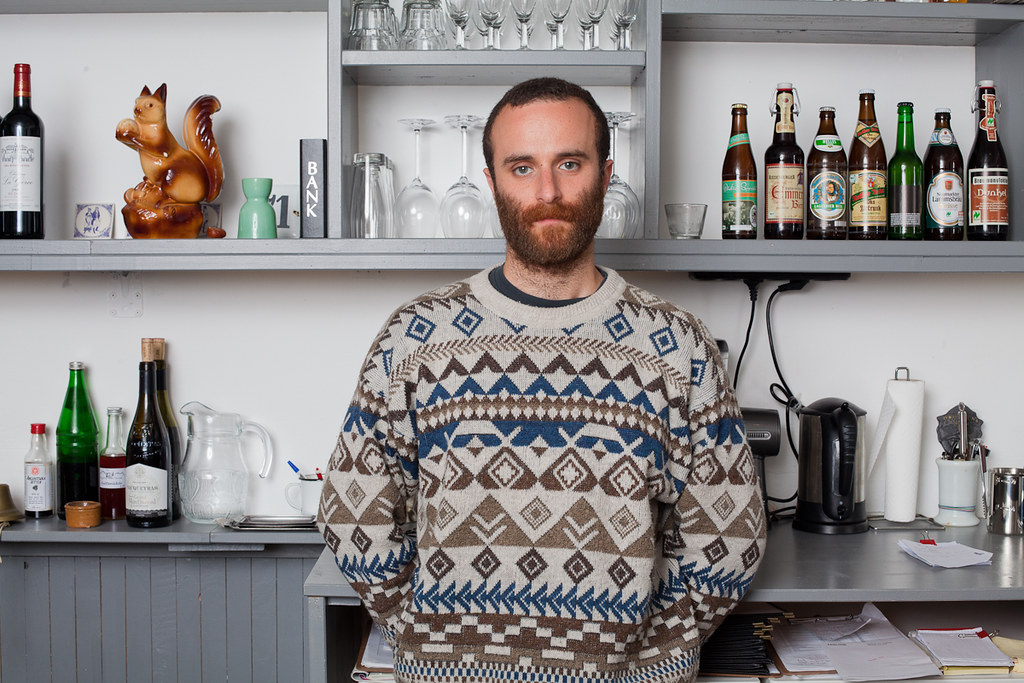
I want to talk more about food, about autumn food. You are going to the market tomorrow, do you already have something in mind that will be up this week?
Kevin: I will be looking for things that I don't expect. I've noticed that the Romanesco is out, I definitely want to make something with that..
What are you going to make?
Kevin: Probably some salad, or maybe fried... I never really know what I am doing until..
But you have to print the menu?
Jeffrey: We print the menu an hour before we open.
Oh.. so you get into the kitchen on Wednesday?
Kevin: Usually I start on Tuesdays at 10, and make a list of what we have and need and then I go to the market and buy all the vegetables and come back and cook. And then usually by the end of Tuesday I know what I want to do on Wednesday. So it depends. The past few weeks we had different things with pumpkin... I am inspired by vegetables, even the meat dishes are based on the vegetables that come along with it. We always have four or five side dishes, only vegetables, that you could have as an appetizer or with your main dish, or you could have a couple as a main dish if you are vegetarian. Like roasted beet roots with the beet's greens and horseradish, roasted pumpkin with goat cheese and honey or cauliflower with tahini sauce.
How did you prepare that?
Kevin: I mix Tahini with lemon juice and garlic and a little bit of soy sauce, and thin it out with a bit of water. The cauliflower is roasted in the oven with olive oil and salt and pepper. Then the sauce is just drizzled on top of it.
That sounds really good.
Kevin: I like to present the vegetables in their natural state. I might not take the skin off the pumpkin or leave the beet root as they are and not slice it. I like the idea of challenging people a little, preparing the dishes in a very simple way. To have people think about what they are eating.
To see what you eat?
Kevin: We've also had pig's head!
What do you mean?
Kevin: We had the head cooked, cut off the meat and serve it in a soup..
Is there so much meat on a pig's head?
Kevin: Kind of.. the cheek is the biggest part. Its more than you think.
What kind of soup was it?
Kevin: Red lentil soup. We cut the meat in pieces and served it in the soup. It was not very popular.
Because of the name I would guess?
Jeffrey: It wasn't very popular, but there were some people who were like, I wanna try it! That were very adventurous and wanted to try something they hadn't eaten before. They were asking questions about it and that was really exciting.
I guess it's a very classic and also organic approach to use the whole animal..
Kevin: Of course. That is a very good point. It is definitely important to us, to get away from the easy things. If something is unpopular, it does not mean that it is bad.
So you are going to bring back the pig's head?
Kevin: For sure! I want to put it in aspic. What it is called in German?
Its called Sülze, Schweinskopfsülze.
Kevin: I'll make that!
So I'll come by and try it.
Kevin: The pig's head meat is so delicious, it doesn't taste as strong as liver or other parts. There is nothing weird or gross about it. I think it's the best part.
But you are always offering vegetarian alternatives?
Jeffrey: Most of the time there is a vegetarian main dish, and half of the menu is vegetarian anyway. You could easily combine a main course out of the sides.
Kevin: We always try to have a vegetarian main dish, there are a lot of vegetarians in Berlin. I was vegetarian for a long time and I like to eat vegetarian a lot so I am more than happy to cook vegetarian.
I recognize you've got a lot of desserts.
Kevin: That's my favorite thing to make, that's why. Some days we only have one..
Jeffrey: Usually we have four, but sometimes we have more. I think a lot of chefs do not like to make desserts, is that true?
Kevin: Yes, I guess.
Jeffrey: But Kevin loves to make desserts and we get some of the strongest reactions out of the desserts. Some people really freak out.
A lot of people would rather freak out on a dessert than on an appetizer. A really well made chocolate cake is so much more impressing..
Kevin: It's because of the sugar and the chocolate. We had one night when two different people had to have another piece of cake, which I've never seen happen in my entire career.
Maybe the body image is not as strong in Berlin as in New York, so you can have another piece of cake.
Kevin: That's true, people seem to be more open to eating a lot. Lots of bread and sugar.
Bread is a German thing.. Please, give us some insights on what is on the menu this week.
Kevin: We will have venison. We've been buying our wild meat from a hunter at Berliner Wildhandel.
From Brandenburg?
Jeffrey: Yes, he has a shop at Mehringdamm and one at Greifswalder, Prenzlauer Berg. He is a hunter and he has other hunters bringing him the butchered meat. He has very interesting stuff, venison, wild goat, Wildschwein, rabbit and Hirsch.
Kevin: So we will have the venison and we will have duck leg, and I am going to make parsnip soup. I will make this vegetarian, with leeks and then pureed, and then we will put fried wild boar ham on top. And I am going to make duck liver pate. And there is one farmer we get really good tomatoes from..
Still?
Kevin: It's almost over. Maybe there is one more week.
The last week of tomatoes for this year!
Kevin: Yes, its a very big deal.
Jeffrey: His tomatoes are very good, its the Schloßgärtnerei.
Kevin: He has the best tomatoes in Berlin I've seen so far. He sells them at the market at the corner of Dieffenbachstraße and Schönleinstraße on Tuesdays.
Jeffrey: It's a very small market and they have only organic stands.
Kevin: I also go to the Turkish market at Maybachufer and there are three or four people that have really nice stuff.
The one market stand right by Kottbusser Damm, the really big one?
Kevin: Yes, that's the good one. And then there is Roberto with his Wilde Gärtnerei, we get the apple and pear juice from him. He has amazing vegetables and he grows all these varieties of wild lettuces and we always have a salad that is made from his lettuces and herbs. He probably grows twenty different kinds of weeds and lettuces. I really think the farmers deserve a lot of praise and credit.
For still doing this?
Kevin: Yes, because I really work hard, but I don't have to get up at four in the morning and drive two hours to Berlin hoping that people will buy my vegetables.
And did you already plan the desserts?
Kevin: Yes, I will make a Persimon pudding. Which is not from Brandenburg, but it's really delicious. I can't resist.
Do you test all the dishes at home?
Kevin: A lot of the things I did for a long time. I haven't really cooked anything at home since we opened..
So what are you eating at home?
Jeffrey: Leftovers!
Which is not too bad.
Kevin: And sometimes I enjoy frozen pizza and gummibärs. I am not a food fascist.
Interview: Mary Scherpe
Photography: Trevor Good








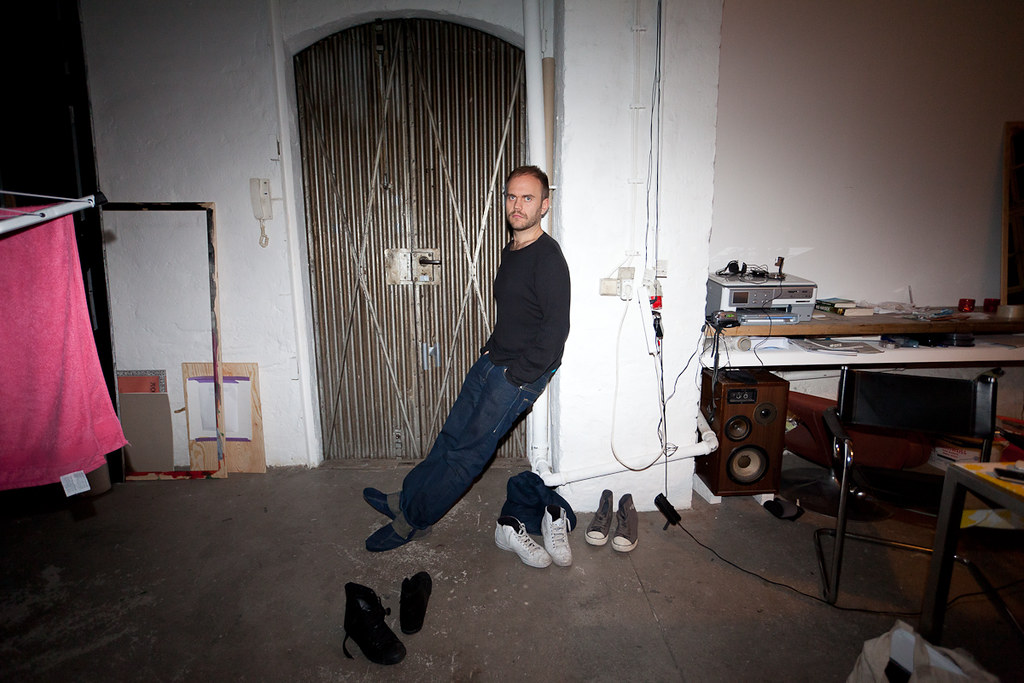













 Its been a busy week here with lots of vintage pieces flying out the door - Daisy Lowe has bought a lovely silk floral 1930s tea dress, my friends daughter Issy has taken away a 1950s sailors jacket, (she is the most stylish 16 year old in Bristol) designers have picked up some beaded and printed pieces and I have put aside all things Bridal for a meeting with more designers on Monday.... so now I am back on the (eternal) quest for more beautiful things. I went to see Brian and Roger, my friends in Bath, yesterday to sort out their 70s and 80s pieces for the up and coming auction (February 1st, Clifton, Bristol, full details coming soon!) but we did not get much work done...they ended up showing me the things that are not for sale. So many wonderful pieces, better fun than a museum as they let me try things on! The best pieces for me that I saw were a 1915 Lanvin couture evening coat and a 1930s Jean Desses (yes dated and numbered!) silk grecian dress, late 1930s with the most incredible hem, it reminded me of a car engine...wish I had a photo to show you what I mean! Anyway, I ended up convincing them to sell me a Rudi Gernreich dress, black wool with sweet neck and cuff details...I will be wearing it to death this winter, even if it is far too short, will look fantastic with black jeans and boots....xx ps: The next vintage fashion fair coming up is the lovely Frock Me, 31st October from 11 am, do email me for tickets.
Its been a busy week here with lots of vintage pieces flying out the door - Daisy Lowe has bought a lovely silk floral 1930s tea dress, my friends daughter Issy has taken away a 1950s sailors jacket, (she is the most stylish 16 year old in Bristol) designers have picked up some beaded and printed pieces and I have put aside all things Bridal for a meeting with more designers on Monday.... so now I am back on the (eternal) quest for more beautiful things. I went to see Brian and Roger, my friends in Bath, yesterday to sort out their 70s and 80s pieces for the up and coming auction (February 1st, Clifton, Bristol, full details coming soon!) but we did not get much work done...they ended up showing me the things that are not for sale. So many wonderful pieces, better fun than a museum as they let me try things on! The best pieces for me that I saw were a 1915 Lanvin couture evening coat and a 1930s Jean Desses (yes dated and numbered!) silk grecian dress, late 1930s with the most incredible hem, it reminded me of a car engine...wish I had a photo to show you what I mean! Anyway, I ended up convincing them to sell me a Rudi Gernreich dress, black wool with sweet neck and cuff details...I will be wearing it to death this winter, even if it is far too short, will look fantastic with black jeans and boots....xx ps: The next vintage fashion fair coming up is the lovely Frock Me, 31st October from 11 am, do email me for tickets.



















